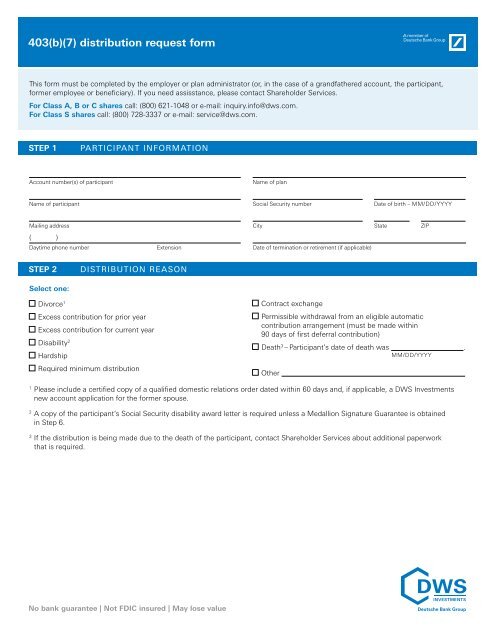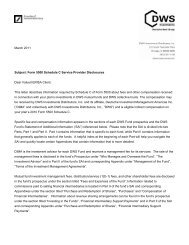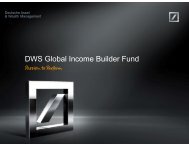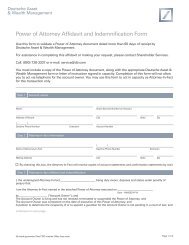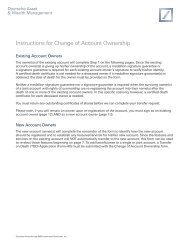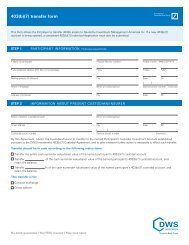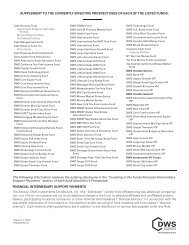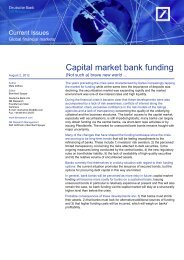403(b)(7) Distribution Request Form - DWS Investments
403(b)(7) Distribution Request Form - DWS Investments
403(b)(7) Distribution Request Form - DWS Investments
Create successful ePaper yourself
Turn your PDF publications into a flip-book with our unique Google optimized e-Paper software.
<strong>403</strong>(b)(7) distribution request form<br />
This form must be completed by the employer or plan administrator (or, in the case of a grandfathered account, the participant,<br />
former employee or beneficiary). If you need assisstance, please contact Shareholder Services.<br />
For Class A, B or C shares call: (800) 621-1048 or e-mail: inquiry.info@dws.com.<br />
For Class S shares call: (800) 728-3337 or e-mail: service@dws.com.<br />
STEP 1<br />
Participant information<br />
Account number(s) of participant<br />
Name of plan<br />
Name of participant<br />
Social Security number<br />
Date of birth – MM/DD/YYYY<br />
Mailing address<br />
( )<br />
Daytime phone number<br />
Extension<br />
City State ZIP<br />
Date of termination or retirement (if applicable)<br />
STEP 2<br />
<strong>Distribution</strong> reason<br />
Select one:<br />
Divorce 1<br />
Excess contribution for prior year<br />
Excess contribution for current year<br />
Disability 2<br />
Hardship<br />
Required minimum distribution<br />
Contract exchange<br />
Permissible withdrawal from an eligible automatic<br />
contribution arrangement (must be made within<br />
90 days of first deferral contribution)<br />
Death 3 – Participant’s date of death was .<br />
MM/DD/YYYY<br />
Other<br />
1<br />
Please <br />
include a certified copy of a qualified domestic relations order dated within 60 days and, if applicable, a <strong>DWS</strong> <strong>Investments</strong><br />
new account application for the former spouse.<br />
2<br />
A <br />
copy of the participant’s Social Security disability award letter is required unless a Medallion Signature Guarantee is obtained<br />
in Step 6.<br />
3<br />
If <br />
the distribution is being made due to the death of the participant, contact Shareholder Services about additional paperwork<br />
that is required.<br />
No bank guarantee | Not FDIC insured | May lose value
STEP 3A<br />
one-time distribution request(s) (immediate distributions)<br />
Section A: <strong>Distribution</strong> option<br />
Direct rollover distribution to:<br />
Traditional IRA<br />
New <strong>DWS</strong> Traditional IRA (attach a completed <strong>DWS</strong> IRA application)<br />
Existing <strong>DWS</strong> Traditional IRA<br />
<strong>DWS</strong> account number<br />
Non-<strong>DWS</strong> <strong>Investments</strong> Traditional IRA<br />
Eligible employer retirement plan<br />
Roth IRA<br />
New <strong>DWS</strong> Roth IRA (attach a completed <strong>DWS</strong> IRA application)<br />
Existing <strong>DWS</strong> Roth IRA<br />
<strong>DWS</strong> account number<br />
Non-<strong>DWS</strong> <strong>Investments</strong> Roth IRA<br />
<strong>Distribution</strong> to participant or employer:<br />
Single lump sum (100%) payment to participant<br />
Single lump sum (100%) payment to employer<br />
Partial payment to participant<br />
Partial payment to employer<br />
Section B: Account information and distribution amount<br />
$ % Close account<br />
Fund name, number, or NASDAQ symbol Account number Dollar amount OR Percentage<br />
$ % Close account<br />
Fund name, number, or NASDAQ symbol Account number Dollar amount OR Percentage<br />
$ % Close account<br />
Fund name, number, or NASDAQ symbol Account number Dollar amount OR Percentage<br />
STEP 3B<br />
AUTOMATIC WITHDRAWAL PLAN request (periodic distributions)<br />
Section A: <strong>Distribution</strong> option<br />
Select one distribution option:<br />
Distribute the account(s) below over the participant’s life expectancy. The participant’s birth date is: .<br />
MM/DD/YYYY<br />
Distribute the account(s) listed below over the joint life expectancy of the participant and<br />
his/her spousal beneficiary who is more than ten years younger. 1 The spouse’s birth date is: .<br />
MM/DD/YYYY<br />
Distribute the account(s) listed below over a fixed period of<br />
Distribute dollar amount(s) from the account(s) listed below. 2<br />
Distribute percent(s) of the shares in the account(s) listed below. 2<br />
years.<br />
1<br />
The spousal beneficiary designation must also be on file with the employer or plan administrator.<br />
2<br />
Subject to the 20% mandatory federal withholding requirement.<br />
continued on next page<br />
Page 2 of 11
STEP 3B<br />
AUTOMATIC WITHDRAWAL PLAN request (periodic distributions) continued<br />
Section B: Account information and distribution amount<br />
A) Indicate the month and year you want your automatic withdrawal plan to begin 3<br />
MM/YYYY<br />
B) Select the frequency of your withdrawal: (If no frequency is indicated, automatic withdrawal plan will be monthly.)<br />
Monthly (12 times a year) Semi-monthly (24 times a year) Bi-monthly (6 times a year)<br />
Quarterly (4 times a year) Semi-annually (2 times a year) Annually (1 time a year)<br />
C) Complete the information below for your periodic distributions:<br />
$ %<br />
Fund name, number, or NASDAQ symbol Account number Dollar amount OR Percentage Day(s) of the month<br />
$ %<br />
Fund name, number, or NASDAQ symbol Account number Dollar amount OR Percentage Day(s) of the month<br />
$ %<br />
Fund name, number, or NASDAQ symbol Account number Dollar amount OR Percentage Day(s) of the month<br />
3<br />
Note: If you do not select a day, we will automatically process your withdrawal on the 25th day of the month. If the day you select<br />
falls on a weekend or holiday, your withdrawal will be made on the next business day. We must receive this form seven days prior to<br />
the day you wish your withdrawal to begin. Otherwise, your AWP will begin the following month.<br />
3<br />
3<br />
3<br />
STEP 4<br />
payment method<br />
Select one:<br />
Direct rollover to a Traditional or Roth IRA<br />
To a new <strong>DWS</strong> <strong>Investments</strong> IRA<br />
To an established <strong>DWS</strong> Invesments IRA:<br />
<strong>DWS</strong> account number<br />
To the following custodian 1 :<br />
Name of custodian<br />
Account number<br />
Mailing address<br />
City State ZIP<br />
Direct rollover to an eligible plan 1 :<br />
Name of trustee/custodian<br />
Account number<br />
Mailing address of trustee/custodian<br />
City State ZIP<br />
Participant<br />
1<br />
All distribution checks, including those for direct rollovers, will be sent to the address of record if you do not supply a complete<br />
address for the custodian of the new IRA or trustee/custodian of the eligible employer plan. For a direct rollover, the participant will<br />
need to forward the check to the custodian of the new IRA or trustee/custodian of the eligible employer plan.<br />
continued on next page<br />
Page 3 of 11
STEP 4<br />
payment method continued<br />
Mail distribution check(s) to participant at the account’s address of record<br />
Send the distribution(s) to the bank account indicated below 2<br />
Tape a voided check or deposit slip here to transfer money between the bank and the participant’s <strong>DWS</strong> <strong>Investments</strong> account.<br />
The name and address must be preprinted on the check or deposit slip. Please write “VOID” on the check before sending.<br />
John A. Sample<br />
123 Some Street<br />
Anywhere, USA 12345<br />
Date<br />
1083<br />
PAY TO THE<br />
ORDER OF<br />
ANY BANK, USA<br />
VOID<br />
Dollars<br />
For<br />
0123000456 789 12345 0678<br />
Please indicate the type of account at the financial institution. Only one type should be selected. If no selection is made,<br />
checking will be the default. We cannot establish banking services from cash management, brokerage or mutual fund checks.<br />
Checking OR Savings<br />
Make check(s) payable to someone other than the participant or to an address other than the address on record.<br />
Note: Please obtain a signature guarantee when completing Step 6.<br />
Name of payee Mailing address City State ZIP<br />
2<br />
If the bank account registration is different from the <strong>DWS</strong> <strong>Investments</strong> account registration, please obtain a signature guarantee<br />
when completing Steps 6.<br />
STEP 5<br />
tax withholding information<br />
Before selecting a withholding option, please consult your legal or tax counsel for advice and information concerning your particular<br />
situation. Neither <strong>DWS</strong> <strong>Investments</strong> nor any of its representatives may give tax or legal advice. Withholding requirements, exclusions<br />
and withholding tax rates are subject to change at any time. For the most up-to-date information on your state’s tax withholding<br />
requirements, visit your state’s website.<br />
For states and the District of Columbia that mandate state withholding on distributions, <strong>DWS</strong> <strong>Investments</strong> will automatically withhold<br />
the minimum required amount and forward it to the appropriate revenue service unless you instruct us to withhold a greater amount<br />
in the state withholding section below.<br />
Federal withholding<br />
If you do not select a box relating to federal withholding, 10% of your distribution(s) will be withheld and forwarded to the IRS. If<br />
the participant elected to receive all or a portion of his/her account in cash and his/her distribution is a participant eligible rollover<br />
distribution, 20% of the distribution will automatically be withheld and forwarded to the IRS unless an exception applies. If the<br />
participant’s distribution is not an eligible rollover distribution, then the above withholding election will apply.<br />
Do not withhold any federal income taxes from my distribution(s). I understand that state withholding may be required.<br />
Withhold 10% of the distribution amount(s) and forward it to the IRS. I understand that state withholding may be required.<br />
Withhold<br />
% of the distribution amount(s) and forward to the IRS. (Not to be less than 10%) I understand that state<br />
withholding may be required.<br />
continued on next page<br />
Page 4 of 11
STEP 5<br />
tax withholding information continued<br />
State withholding<br />
If you would like to have voluntary state withholding taken, please indicate below. If a state withholding option is selected and your<br />
state does not accept withholding, <strong>DWS</strong> <strong>Investments</strong> will not take a state withholding from your distribution(s).<br />
Withhold $<br />
of the distribution amount(s) and forward to my state revenue service. (If the dollar amount provided is<br />
less than the state minimum, <strong>DWS</strong> <strong>Investments</strong> will withhold the minimum amount required by your state.)<br />
STEP 6 Signature(s)<br />
<strong>403</strong>(b)(7) participant<br />
(Required for grandfathered accounts established prior to January 1, 2009.)<br />
I certify under penalties of perjury that the Social Security number provided on this form is correct and I am a US citizen or<br />
US resident alien. I request the above distribution and certify that I am (or the indicated alternate payee is) the proper party to<br />
receive payment(s) from this <strong>403</strong>(b)(7) custodial account, that the information provided is true and accurate and that I terminated<br />
employment with the <strong>403</strong>(b)(7) plan sponsor before January 1, 2009. I am aware of the tax consequences of taking this distribution.<br />
I certify that I have read the “Special tax notice regarding <strong>403</strong>(b)(7) plan payments,” which explains the tax options for plan<br />
distributions including the rollover options, federal income tax withholding and the special tax treatment of lump sum distributions.<br />
The Internal Revenue Service does not require your consent to any provision of this document other than certification of your<br />
Social Security number.<br />
Affix Medallion Signature Guarantee or Guarantee stamp<br />
Name of participant (please print)<br />
Signature of <strong>403</strong>(b)(7) participant †<br />
Date – MM/DD/YYYY<br />
Special note to Medallion Signature Guarantee guarantors: By affixing the Medallion Signature Guarantee, you are verifying the<br />
identity of the individuals and entities assigned to this account and are accepting liability for any misrepresentation as it applies<br />
to this registration and any accompanying documentation.<br />
† If acting on behalf of the account owner, you must sign in the capacity of your title as it relates to this account, i.e. Joe Smith,<br />
Attorney-in-Fact; Mary Jackson, Guardian; etc. The institution providing the Medallion Signature Guarantee for these types of<br />
accounts will require additional documentation. You may wish to contact the institution to confirm the documentation they require<br />
to provide you with a Medallion Signature Guarantee.<br />
continued on next page<br />
Page 5 of 11
STEP 6 Signature(s) continued<br />
Employer or plan administrator<br />
(Note: For grandfathered accounts established before January 1, 2009, the plan administrator’s signature is not required.)<br />
The employer or plan administrator certify that the <strong>403</strong>(b)(7) participant listed above has incurred an event qualifying for a distribution<br />
according to the employer’s plan or, if applicable, authorizes the contract exchange and that such amounts are fully vested and<br />
nonforfeitable. I understand that <strong>DWS</strong> Trust Company is not liable for processing this distribution request at my direction and has<br />
no duty to determine if this request complies with the terms of the employer’s plan or its permissibility under the Internal Revenue<br />
Service rules.<br />
Affix Medallion Signature Guarantee or Guarantee stamp<br />
Name of employer (please print)<br />
Signature of employer or plan administrator<br />
Date – MM/DD/YYYY<br />
Medallion Signature Guarantee<br />
A Medallion Signature Guarantee is issued by a bank, savings and loan, trust company, credit union, broker/dealer, or any member<br />
or participant of an approved signature guarantee program. Please note that a notary public is not an acceptable guarantor. An officer<br />
of the institution will ask for identification to be sure that you are, in fact, the person identified on this form and the person signing it.<br />
Once the guarantor has reviewed your request, verified your identity and your authority to act on the account presented to them, they<br />
will affix a Medallion Signature Guarantee stamp to your form.<br />
<strong>DWS</strong> prefers Medallion Signature Guarantee stamps. We must receive an original stamp. If more than one signature is required on<br />
this form, we will need separate stamps for each signature. If you are obtaining a non-Medallion Signature Guarantee, please contact<br />
us. We may require additional documentation to complete your request.<br />
Please mail completed form to:<br />
<strong>DWS</strong> <strong>Investments</strong> Service Company<br />
P.O. Box 219557<br />
Kansas City, MO 64121-9557<br />
Overnight Address:<br />
<strong>DWS</strong> <strong>Investments</strong> Service Company<br />
210 W. 10th Street<br />
Kansas City, MO 64105-1614<br />
<strong>DWS</strong> <strong>Investments</strong> Distributors, Inc.<br />
222 South Riverside Plaza<br />
Chicago, IL 60606-5808<br />
www.dws-investments.com<br />
© 2012 <strong>DWS</strong> <strong>Investments</strong> Distributors, Inc. All rights reserved. (04/12) B-004559-6 <strong>Form</strong>-06R<br />
Page 6 of 11
Special tax notice regarding <strong>403</strong>(b)(7) plan payments<br />
This notice contains important information describing how to receive your benefits from your <strong>403</strong>(b)(7) custodial account. This notice<br />
summarizes only the federal (not state or local) tax rules that might apply to your payment. The rules are complex and contain many<br />
conditions and exceptions that are not included in this notice. Therefore, you may want to consult with a professional tax advisor<br />
before you take a payment of your benefits.<br />
Summary<br />
A payment from the plan that is eligible for “rollover” can be taken in two ways. You can have all or any portion of your payment<br />
either 1) paid in a “direct rollover” or 2) paid to you. A rollover is payment of your benefits to your traditional Individual Retirement<br />
Arrangement (IRA) or to an eligible employer plan which you have designated that will accept it and hold it for your benefit. This<br />
choice will affect the tax you owe.<br />
If you choose a direct rollover:<br />
n Your payment will not be taxed in the current year and no income tax will be withheld.<br />
n You choose whether your payment will be made directly to your Traditional IRA or to an eligible employer plan that accepts<br />
your rollover.<br />
n Your payment will be taxed later when you take it out of the Traditional IRA or the eligible employer plan.<br />
n Your payment cannot be rolled over to a Roth IRA (except as described in 5 below), SIMPLE IRA or a Coverdell Education<br />
Savings Account.<br />
If you choose to have your plan benefits paid to you:<br />
n You will receive only 80% of the payment, because the plan administrator is required to withhold 20% of the payment and send it to<br />
the IRS as income tax withholding to be credited against your taxes.<br />
n Your payment will be taxed in the current year unless you roll it over. Under limited circumstances, you may be able to use special<br />
tax rules that could reduce the tax you owe. However, if you receive payment before age 59½, you may also have to pay an<br />
additional 10% tax.<br />
n You can roll over the payment by paying it to your IRA or to an eligible employer plan that accepts your rollover within 60 days of<br />
receiving the payment. The amount rolled over will not be taxed until you take it out of the IRA or the eligible employer plan.<br />
n If you want to roll over 100% of the payment to an IRA or an eligible employer plan, you must use other money to replace the<br />
20% that was withheld. If you roll over only the 80% that you received, you will be taxed on the 20% that was withheld and that<br />
is not rolled over.<br />
Your right to waive the 30-day notice period<br />
Generally, neither a direct rollover nor a payment can be made from the plan until at least 30 days after your receipt of this notice.<br />
Thus, after receiving this notice, you have at least 30 days to consider whether or not to have your withdrawal directly rolled over. If<br />
you do not wish to wait until this 30-day notice period ends before your election is processed, you may waive the notice period by<br />
making an affirmative election indicating whether or not you wish to make a direct rollover. Your withdrawal will then be processed<br />
in accordance with your election as soon as practical after it is received by the <strong>403</strong>(b)(7) custodian.<br />
No bank guarantee | Not FDIC insured | May lose value<br />
Page 7 of 11
more information<br />
1. Payments that can and cannot be rolled over<br />
Payments from your <strong>403</strong>(b)(7) custodial account may be “eligible rollover distributions.” This means that they can be rolled over to a<br />
Traditional IRA or to an eligible employer plan that accepts rollovers. Payments may not be rolled over to a Roth IRA, SIMPLE IRA or a<br />
Coverdell Education Savings Account.<br />
After-tax contributions<br />
If you made after-tax contributions to your <strong>403</strong>(b)(7) custodial account, these contributions may be rolled into either a Traditional IRA<br />
or to certain employer plans that accept rollovers of the after-tax contributions. The following rules apply:<br />
a. Rollover into an IRA<br />
If you roll over after-tax contributions to an IRA, it is your responsibility to keep track of, and report to the IRS on the applicable<br />
forms, the amount of these after-tax contributions. This will enable the nontaxable amount of any future distributions from the IRA<br />
to be determined.<br />
Once you roll over your after-tax contributions to an IRA, those amounts cannot later be rolled over to an employer plan.<br />
b. Rollover into an employer plan<br />
You can roll over after-tax contributions from your <strong>403</strong>(b)(7) custodial account to another <strong>403</strong>(b) plan using a direct rollover if the<br />
other <strong>403</strong>(b) plan provides separate accounting for amounts rolled over, including separate accounting for the after-tax employee<br />
contributions and earnings on those contributions. You cannot roll over after-tax contributions to a governmental 457 plan. If<br />
you want to roll over your after-tax contributions to an employer plan that accepts these rollovers, you cannot have the after-tax<br />
contributions paid to you first. You must instruct the <strong>403</strong>(b)(7) custodian to make a direct rollover on your behalf. Also, you cannot<br />
first roll over after-tax contributions to an IRA and then roll over that amount into an employer plan.<br />
The following types of payments cannot be rolled over:<br />
Payments spread over long periods<br />
You cannot roll over a payment if it is part of a series of equal (or almost equal) payments that are made at least once a year and that<br />
will last for:<br />
n your lifetime (or life expectancy), or<br />
n your lifetime and your beneficiary’s lifetime (or joint life expectancies), or<br />
n a period of 10 years or more.<br />
Required minimum payments<br />
Beginning when you reach age 70½ or retire, whichever is later, a certain portion of your payment cannot be rolled over because it<br />
is a “required minimum payment” that must be paid to you. If you own more than 5% of your employer that sponsors the <strong>403</strong>(b)(7)<br />
plan, you must receive your “required minimum payment” when you reach age 70½ even though you may still be working. Separate<br />
rules may apply if you have pre-1987 benefits that have been distinctly accounted for and maintained to preserve their identity as<br />
such. Another exception may be applicable to post-1986 benefits of government or church employees. Check with your employer if<br />
you feel either of these situations might apply to you.<br />
Hardship distributions<br />
A hardship distribution cannot be rolled over.<br />
Corrective distributions<br />
A distribution that is made to correct a failed nondiscrimination test or because legal limits on certain contributions were exceeded<br />
cannot be rolled over.<br />
Loans treated as distributions<br />
The amount of a plan loan that becomes a taxable deemed distribution because of a default cannot be rolled over. However, a loan<br />
offset amount is eligible for rollover, as discussed in Section 3 below.<br />
2. Direct Rollover<br />
You can choose a direct rollover of all or any portion of your payment that is an “eligible rollover distribution,” as described above. If<br />
you elect a direct rollover and you do not provide a complete address for the custodian or trustee of the IRA or eligible employer plan,<br />
<strong>DWS</strong> Trust Company will give you a check made payable to the new custodian or trustee of the IRA or eligible employer plan. You<br />
must then deliver the check to that custodian or trustee. A direct rollover amount is not subject to taxation until you later receive a<br />
distribution from the IRA or eligible plan that received the rollover. In addition, no income tax withholding is required for any taxable<br />
portion of your <strong>403</strong>(b)(7) benefits for which you choose a direct rollover. Your <strong>403</strong>(b)(7) plan might not let you choose a direct rollover<br />
if your distributions for the year are less than $200.<br />
continued on next page<br />
Page 8 of 11
more information continued<br />
Direct rollover to an IRA<br />
You can open an IRA to receive the direct rollover. (The term IRA as used in this notice, includes Individual Retirement Accounts and<br />
Individual Retirement Annuities.) If you choose to have your payment made directly to an IRA, contact an IRA sponsor (usually a<br />
financial institution) to find out how to have your payment made in a direct rollover to an IRA at that institution. If you are unsure of<br />
how to invest your money, you can temporarily establish an IRA to receive the payment. However, in choosing an IRA, you may wish<br />
to consider whether the IRA you choose will allow you to move all or part of your payment to another IRA at a later date, without<br />
penalties or other limitations. See IRS Publication 590, Individual Retirement Arrangements, for more information on IRAs (including<br />
limits on how often you can roll over between IRAs).<br />
Direct rollover to an eligible employer plan<br />
If you are employed by a new employer that has an eligible employer plan and you want to do a direct rollover to that plan, ask the<br />
employer whether the plan will accept your rollover. A plan is not legally required to accept a rollover. If your new employer’s plan<br />
does not accept a rollover, you can choose a direct rollover to an IRA. If the employer plan accepts your rollover, the plan may provide<br />
restrictions on the circumstances under which you may later receive a distribution of the rollover amount or may require spousal<br />
consent to any subsequent distribution. Check with the employer of that plan before making your decision.<br />
Direct rollover of a series of payments<br />
If you receive a series of payments over a period of less than ten years, each payment is an eligible rollover distribution. Your choice<br />
to make a direct rollover will apply to all payments until you change your election. You are free to change your election for any later<br />
payments in the series.<br />
Change in tax treatment resulting from a direct rollover<br />
The tax treatment of any payment from the eligible employer plan or IRA receiving your direct rollover might be different than if you<br />
received your benefit in a taxable distribution directly from the plan.<br />
See the section below entitled "Additional 10% tax if you are under age 59½".<br />
3. Payment paid to you<br />
If your payment can be rolled over under Section 2 above and the payment is made to you, it is subject to 20% federal income tax<br />
withholding (state tax withholding may also apply). The payment is taxed in the year you receive it unless, within 60 days, you roll it<br />
over to an IRA or an eligible employer plan that accepts rollovers. If you do not roll it over, special tax rules may apply. Following is<br />
general information about income tax withholding.<br />
Mandatory withholding<br />
If any portion of your payment can be rolled over and you do not elect to make a direct rollover, the custodian is required by law to<br />
withhold 20% of that amount and send it to the IRS. For example, if your eligible rollover distribution is $10,000, only $8,000 will be<br />
paid to you because the custodian must withhold $2,000 as income tax. However, when you prepare your income tax return for the<br />
year, unless you make a rollover within 60 days (see “60-day rollover option” below), you must report the full $10,000 as a payment<br />
from the plan. You must report $2,000 as tax withheld, and it will be credited against any income tax you owe for the year. There will<br />
be no income tax withholding if your payments for the year are less than $200.<br />
Voluntary withholding<br />
If any portion of your payment is not an eligible rollover distribution but is taxable, the mandatory withholding rules described above<br />
do not apply. In this case, you may elect not to have withholding apply to that portion. If you do nothing, an amount will be taken out<br />
of this portion of your payment for federal income tax withholding. To elect out of withholding, contact the custodian of your <strong>403</strong>(b)<br />
plan for the election form and related information.<br />
continued on next page<br />
Page 9 of 11
more information continued<br />
Sixty-day rollover option<br />
If you have an eligible rollover distribution paid to you, you can still decide to roll over all or part of it to an IRA or to an eligible<br />
employer plan that accepts rollovers. If you decide to roll over your payment, you must make the rollover within 60 days after you<br />
receive the payment. The portion of your payment that is rolled over will not be taxed until you take it out of the IRA or the eligible<br />
employer plan.<br />
You can roll over up to 100% of the eligible rollover distribution, including an amount equal to the 20% that was withheld. If you<br />
choose to roll over 100%, you must use other money within the 60-day period to contribute to the IRA or the eligible employer plan to<br />
replace the 20% that was withheld. On the other hand, if you roll over only the 80% that you received, you will be taxed on the 20%<br />
that was withheld.<br />
Example: Your eligible rollover distribution is $10,000, and you choose to have it paid to you. You will receive $8,000, and $2,000 will<br />
be sent to the IRS as income tax withholding. Within 60 days after receiving the $8,000, you may roll over the entire $10,000 to an<br />
IRA or an eligible employer plan. To do this, you roll over the $8,000 you received from the plan, and you will have to use $2,000 from<br />
other sources (your savings, a loan, etc.).<br />
In this case, the entire $10,000 is not taxed until you take it out of the IRA or eligible employer plan. If you roll over the entire $10,000,<br />
you may get a refund of the mandatory $2,000 that was withheld when you file your income tax return.<br />
If, on the other hand, you roll over only $8,000, the $2,000 you did not roll over is taxed in the year it was withheld. When you file<br />
your income tax return, you may get a refund of part of the $2,000 that was withheld. However, any refund is likely to be larger if you<br />
roll over the entire $10,000.<br />
Additional 10% tax if you are under age 59½<br />
If you receive a payment before you reach age 59½ and you do not roll it over, in addition to the regular income tax, you<br />
may have to pay an extra tax equal to 10% of the taxable portion of the payment. The additional 10% tax does not apply to your<br />
payment if it is:<br />
1. Paid to you because you separate from service with your employer during or after the year you reach age 55.<br />
2. Paid because you retire due to disability.<br />
3. Paid to you as equal (or almost equal) payments over your life or life expectancy (or your and your beneficiary’s lives or<br />
life expectancies).<br />
4. A payment that is paid directly to the government to satisfy a federal tax levy made after December 31, 1999.<br />
5. A payment that is paid to an alternate payee under a qualified domestic relations order.<br />
6. A payment that does not exceed the amount of your deductible medical expenses.<br />
The additional 10% tax will not apply to distributions from a governmental 457 plan, except to the extent the distribution is<br />
attributable to an amount you rolled over to that plan (adjusted for investment returns) from another type of eligible employer plan<br />
or IRA. Any amount rolled over from a governmental 457 plan to another type of eligible employer plan or to a Traditional IRA will<br />
become subject to the additional 10% tax if it is distributed to you before you reach age 59½, unless one of the exceptions applies.<br />
See IRS <strong>Form</strong> 5329 for more information on the additional 10% tax.<br />
Loan repayment and offset<br />
If you end your employment with your employer and have an outstanding loan from your <strong>403</strong>(b)(7) custodial account, your<br />
<strong>403</strong>(b)(7) account balance may be reduced (or “offset”) by the amount of the loan you have not repaid. The amount of your loan<br />
offset is treated as a distribution to you at the time of the offset and will be taxed unless you roll over an amount equal to the amount<br />
of your loan offset to an IRA or another qualified employer plan within 60 days of the date of the offset. If the amount of your loan<br />
offset is the only amount you receive (because, for example, you have made a direct rollover of the balance of your account) or are<br />
treated as having received, no tax withholding will be taken. If you receive other payment from your <strong>403</strong>(b)(7) account, the 20%<br />
withholding amount will be based on the entire amount paid to you, including the amount of the outstanding loan balance, but the<br />
amount withheld will not exceed the amount of the distribution made to you. A taxable distribution may also occur if you default on<br />
a loan under the <strong>403</strong>(b) plan and the plan considers the default a “deemed distribution.” The amount of a defaulted plan loan that is a<br />
taxable deemed distribution cannot be rolled over.<br />
continued on next page<br />
Page 10 of 11
more information continued<br />
4. Surviving spouses, alternate payees and other beneficiaries<br />
In general, the rules summarized above that apply to payments to employees also apply to payments to surviving spouses of<br />
employees and to spouses or former spouses who are “alternate payees.” You are an alternate payee if your interest in the plan<br />
results from a “qualified domestic relations order,” which is an order issued by a court, usually in connection with a divorce or legal<br />
separation. Some of the rules summarized above also apply to a deceased employee’s beneficiary who is not a spouse. However,<br />
there are some exceptions for payments to surviving spouses, alternate payees, and other beneficiaries that should be mentioned.<br />
If you are a surviving spouse, you may choose to have an eligible rollover distribution paid in a direct rollover to an IRA or to an<br />
eligible employer plan or paid to you. If you have the payment paid to you, you can keep it or roll it over yourself to an IRA or to an<br />
eligible employer plan. Thus, you have the same choices as the employee.<br />
If you are an alternate payee who is the spouse or former spouse, you have the same choices as the employee. Thus, you can have<br />
the payment paid as a direct rollover or paid to you. If you have it paid to you, you can keep it or roll it over yourself to an IRA or to an<br />
eligible employer plan that accepts rollovers.<br />
If you are a beneficiary other than the surviving spouse (or an alternate payee other than the spouse or former spouse), you cannot<br />
choose a direct rollover, and you cannot roll over the payment yourself.<br />
If you are a surviving spouse, an alternate payee, or another beneficiary, your payment is generally not subject to the additional 10%<br />
tax described in Section 3 above, even if you are younger than age 59½.<br />
5. Special rules for direct rollovers to a Roth IRA<br />
There are special rules which permit you to directly roll over your distribution (not including any amounts attributable to after-tax<br />
contributions) to a Roth IRA. If you choose to do this, the amount of the rollover will be subject to taxation in the year of the rollover<br />
(not including the 10% tax on early distributions). If you made such a rollover in 2010, the amount of the rollover will be taxed ratably<br />
in 2011 and 2012 unless you elect otherwise.<br />
how to obtain additional information<br />
This notice summarizes only the federal (not state or local) tax rules that might apply to your payment. The rules described above are<br />
complex and contain many conditions and exceptions that are not included in this notice. Therefore, you may want to consult with<br />
a professional tax advisor before you take a payment of your benefits from the plan. Also, you can find more specific information<br />
on the tax treatment of payments from qualified employer plans in IRS Publication 575, Pension and Annuity Income, and Individual<br />
Retirement Accounts in IRS Publication 590, Individual Retirement Arrangements. These publications are available from your local IRS<br />
office, by calling (800) TAX-FORM or through the IRS internet website at www.irs.gov.<br />
<strong>DWS</strong> <strong>Investments</strong> Distributors, Inc.<br />
222 South Riverside Plaza<br />
Chicago, IL 60606-5808<br />
www.dws-investments.com<br />
© 2012 <strong>DWS</strong> <strong>Investments</strong> Distributors, Inc. All rights reserved. (04/12) B-004559-6 <strong>Form</strong>-06R


